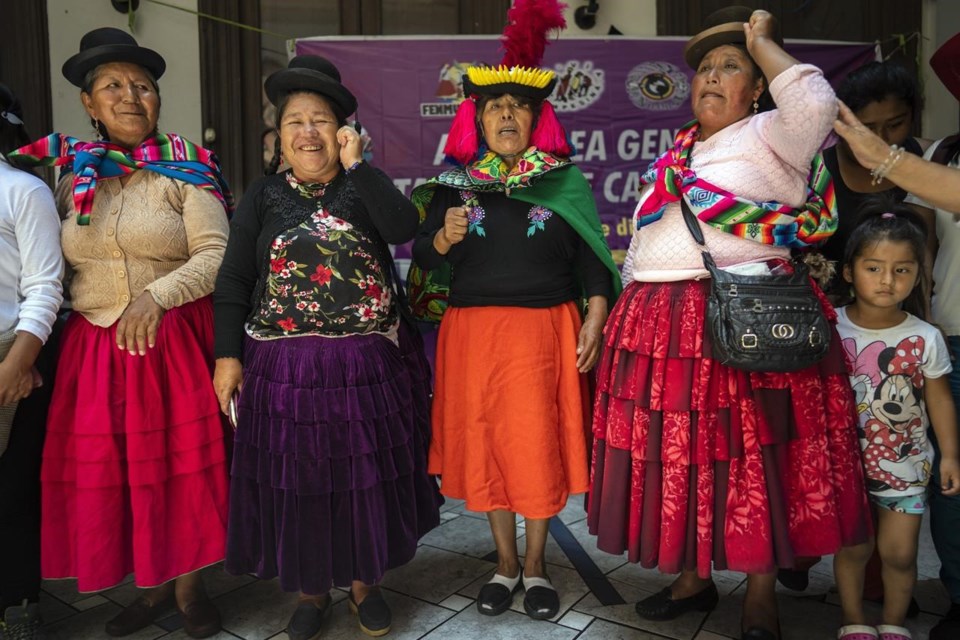LIMA, Peru (AP) — In an industrial corridor of Peru's capital, a dingy stairwell leads to a second-floor safehouse. Dozens of Quechua and Aymara activists lie on mattresses strewn on the floor, resting up for more as volunteers cook a breakfast of donated rice, pasta and vegetables.
Among the makeshift refuge's occupants is Marcelo Fonseca. The 46-year-old watched as a a friend was shot and killed in December as they in the southern city of Juliaca. Within hours, Fonseca joined a caravan of demonstrators that descended on the capital, Lima, to demand the resignation of .
“Our Andean blood burns when we become furious,” Fonseca, whose native language is Quechua, said in a halting Spanish. ”It runs faster. That’s what brings us here.”
Two months into Peru’s angry insurrection, emotions have hardened. While the unrest has barely disturbed the late-night revelry in Lima's beachside enclaves, roadblocks still rage across the countryside, scaring away foreign tourists and leading to shortages of gas and other staples.
The tumult, which has left at least 60 dead, was triggered by the impeachment in December of President Pedro Castillo. To Peruvians like Fonseca, the leftist rural teacher was a symbol of their own exclusion, while Boluarte's ascension to power from the vice presidency in cahoots with Castillo's conservative enemies in Congress is seen as an unforgivable class betrayal.
The impasse has given a jolt of self-confidence to Peru's Indigenous movement. Unlike neighboring Bolivia, where Indigenous groups were emboldened by Aymara coca-grower Evo Morales' election as president in 2006, or Ecuador, where ethnic groups have a long tradition of toppling unpopular governments, Peru's Indigenous groups had long struggled to gain political influence.
Although Peruvians of all backgrounds take pride in the history of the Inca Empire, the country's Indigenous population is often treated with neglect and even hostility. Little is done to promote Quechua, despite its being spoken by millions and being an official language since 1975. Not until the 2017 census were Peruvians even asked whether they identify with any one of 50-plus Indigenous groups.
Tarcila Rivera, a prominent Quechua activist and former adviser to the United Nations on Indigenous issues, attributes the disdain to systemic racism stretching back to the Spanish conquest.
“Despite the two hundred years since the founding of our republic, the reality is that those of us who come from pre-Hispanic civilizations haven't obtained our rights, nor are those rights taken into account,” said Rivera.
The current turmoil has also unleashed a torrent of racism. One lawmaker from the floor of Congress disparaged the rainbow-colored Wiphala flag, which represents the native people of the Andes, as little more than a “chifa tablecloth,” using the word for a cheap Chinese restaurant. Another urged security forces to send protesters to Bolivia with a big “kick.”
Rivera says the crackdown has radicalized younger protesters. Meanwhile, the spread of smartphones and the Internet during the past few has made Indigenous Peruvians more aware of their rights, the country's gaping inequalities and the sacrifices of previously unheralded Indigenous heroes, whose achievements contrast with narratives of perennial victimhood.
“All our kids are ever been taught is that we're losers, miserable souls who were conquered without a fight," Rivera said.
The current protest movement is centered in the southern Andes, where Indigenous identity is strongest. The area is the source of much of Peru's mineral wealth and is home to archeological jewels that attracted more than 4 million tourists a year before COVID.
Its peasants are also among Peru's most neglected.
Those inequalities were on vivid display this month at a roadblock near Cusco, where a group of campesinos sat vigil for hours over a roadblock of tires, tree trunks and boulders. As the line of stranded vehicles grew, tensions flared as motorists complaining that they had family emergencies.
“Don't yell at me when I'm speaking to you with manners!” barked one motorist who faulted the protestors for voting for Castillo, who lived in an adobe home in one of Peru's poorest districts before winning the presidency. “Don't let shameless politicians, who are often from the same community, trick you," he said repeating a false narrative held by elites that Castillo's victory was the result of bribes, fraud and chicanery.
Eventually, the demonstrators yielded to the pressure and briefly opened the road, after a harangue against the “millionaires" and powerful interests blamed for driving their community to desperate actions.
Back in Lima, the safehouse is a hive of activity as another day of demonstrating awaits. Hand-written signs list daily chores to keep the cramped quarters safe and clean. Dozens more activists from Cusco are expected soon and need to be lodged in one of the few dozen homes, apartments and businesses across the capital that have opened their doors, like clandestine rebel bases.
Discretion is a must. Like Fonseca, many of the demonstrators were already detained when security forces firing tear gas last month stormed a university campus at breakfast and arrested hundreds for trespassing. As a result, occupants are encouraged to leave the safehouse one or two at a time, turn off lights early and immediately report any police intrusion to two human-rights attorneys on permanent standby. The windows are covered with newspapers and dog-food bags to block out would-be snoops.
But more than fear, the mood is one of hope.
“No matter what happens, I dare say we've already won,” said Victor Quinones as he stuffs a wad of coca leaves into his cheek.
At 60, Quinones is one of the group's veterans. He says the past few weeks in the capital have strengthened his resolve to push forward and no longer accept the status quo — or futile standoffs with police back home as the best way to change it.
“We broke the barrier. We've started our long march — and look at all this support we've garnered along the way," he reflects. "We've won because, now, the world knows.”
__
Follow Goodman on Twitter: @APJoshGoodman
Joshua Goodman, The Associated Press




